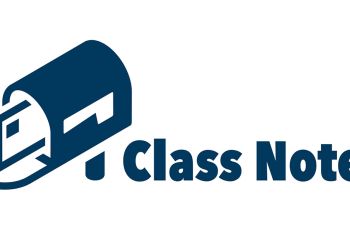SMHS Opens the Doors on a Major Update and Expansion to Its Clinical Learning and Simulation Skills Center
It wasn’t all that long ago that medical students, Physician Assistant students, and others training in the allied health fields relied on the nearly 1,000-page Bates’ Guide to Physical Examination and History Taking to learn the crucial examining skills. “We were instructed that if you put your stethoscope in the right spot and heard crackles in the left lower lobe, it was pneumonia,” says Claudia Ranniger, M.D., Ph.D., assistant professor of emergency medicine at GW’s School of Medicine and Health Sciences (SMHS). Ranniger, co-medical director of the school’s new Clinical Learning and Simulation Skills (CLASS) Center, which opened its doors on the fourth floor of Walter G. Ross Hall this spring, recalls, “as students, our response was often ‘OK, if you say so …’ ‘See one, do one, teach one’ was the aphorism of the day.”
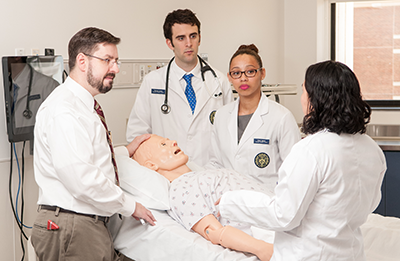
Since those “dark days” a little more than two decades ago, simulation has swept the medical education world. Like the practice of medicine itself, simulation has both a human side and a technological side. The human side is embodied by standardized patients (SPs), carefully trained professionals who play the part of patients suffering from any number of medical maladies. Through face-to-face interaction with SPs, students can perfect their skills at history taking, physical exams, and communication.
“Students get feedback from a variety of sources,” explains Karen Lewis, Ph.D., adjunct assistant professor of medicine at SMHS and administrative director of the CLASS Center. “Not only from the faculty, but also from the standardized patients, from their classmates who are watching the encounters, and even by watching themselves on film.”
In addition to providing first-person feedback, the role of SPs in “enhancing communication skills is especially important,” notes Benjamin (Jim) Blatt, M.D., professor of medicine at SMHS and co-medical director of the CLASS Center. “With SPs, learners at all levels — student, resident, faculty — can improve their ability to communicate difficult topics such as bad news and become better overall caregivers, skilled at alleviating patients’ emotional as well as medical suffering.”
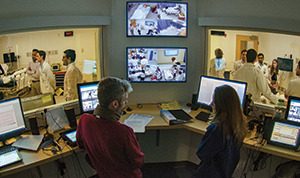
The advances that simulated technology has brought to medical education in the past decade are equally impressive. Rather than taking a professor’s word for it, GW students can now rely on simulation stethoscopes that wirelessly transmit any sound to a stethoscope receiver. “The stethoscope can be preprogrammed so that whenever you hold it over one side of the lungs, you hear the sounds of pneumonia,” explains Ranniger. “Being able to hear the sounds they should be listening for helps students synthesize the data they’re collecting and turn it into a diagnosis,” she says.
The capability to simulate certain aspects of the standard physical examination is just one of a variety of benefits that the new 17,000-square-foot CLASS Center offers medical students, residents, and faculty as well as Physician Assistant, physical therapy, and nursing students. The center, which replaces a much smaller space on the 6th floor of the GW Hospital that had been used for simulation since 2002, features both halves of the simulation world — one side focusing on SPs and the other on technology — joined by a common reception area.
“With standardized patients, learners at all levels — student, resident, faculty — can improve their ability to communicate difficult topics such as bad news and become better overall caregivers, skilled at alleviating patients’ emotional as well as medical suffering.” – Benjamin (Jim) Blatt, M.D., professor of medicine at SMHS and co-medical director of the CLASS Center
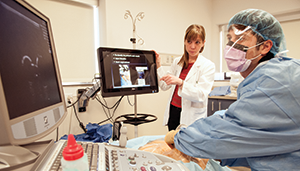
Together, these two components allow SMHS to “train students in the performance of clinical skills, procedures, teamwork, and communication, which we can’t easily do in a patient environment,” Ranniger says. The center complements SMHS’ clinical skills curriculum by giving students what Ranniger calls “a safe place to learn and practice skills without the fear that something bad will happen.”
In addition to 12 outpatient and two inpatient examination rooms for standardized patient encounters, the CLASS Center consists of a labor and delivery suite, a mock operating theater, two high-fidelity rooms, and laboratory space for procedural skills training. Smart Board-equipped conference and debriefing rooms enhance opportunities for performance review — a crucial component of the hands-on training space.
The 99 well-concealed cameras dispersed throughout the center — many of which are mounted low to record facial expression and body position — allow faculty to play back individual and team patient care exercises for students, highlighting the strengths and weaknesses of the performances. “We’re not just interested in patient care in the exam room,” says Ranniger. “The cameras also allow us to monitor what happens during patient transport. How many wires do we run over? How many things do we drop? All of these are important to improve teamwork, which in turn helps us improve care.”
Ranniger explains that the concept of simulation-based mastery learning expects students to learn procedures in the CLASS Center before they are attempted in the real world. “We want students to work in the simulation lab until they’re proficient with the technical skills so that when they’re in the real world and are doing a procedure on a patient, they can manage the procedure and answer the patient’s question instead of having to think about which tool to pick up next.”
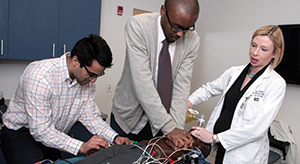
A sophisticated data system allows for curricular content to be pushed from a control room to any of the 32 screens mounted throughout the CLASS Center. X-ray images, footage of real patients, and technique demonstration are just a few types of content that can be displayed to students working in the center. “This makes teaching more consistent, and it makes it easier on faculty because they’re not as worried about developing the content,” says Ranniger. “It takes the burden of minutiae away from the instructor and allows their expertise to be used for the more difficult questions.”
The use of advanced medical simulators, including full-body computerized manikins and haptic surgical trainers, is built into each stage of SMHS’ clinical skills training, which spans all four years of medical education and allows students to develop their skills in scientific and clinical reasoning in parallel. Students can learn the basics of a procedure such as IV placement or resuscitation of a critically ill patient using simple anatomic models. More advanced trainees can transition to high-fidelity simulators where students can practice diagnostic skills, integrate previously learned procedures into patient care, and improve teamwork and communications skills. The Physician Assistant program incorporates an abbreviated version of the course, requiring mastery of skills such as blood draws, basic CPR, and wound care.

assistant students.
Blatt also stresses the value of the center as a laboratory for medical education research. “Simulation exercises permit us to see and measure how large numbers of learners perform in clinical-type situations, allowing us to assess the effectiveness of new educational methods. For obvious reasons we could not do this kind of research with real patients.” In a 2010 study published in the journal Academic Medicine, for example, Blatt and research partner Susan LeLacheur, Dr.P.H., M.P.H., associate professor of Physician Assistant studies, demonstrated that an intervention called perspective-taking improved patient satisfaction with students’ interpersonal skills in encounters with SPs. Because patient satisfaction has been linked to better patient outcomes, discovering methods to enhance students’ interpersonal skills is an important mission for medical education. Blatt has also collaborated with medical schools in the Mid-Atlantic Consortium in a study of gender and ethnic bias in the student-SP interactions. The consortium study will appear in Academic Medicine later this year.
The expanded size of the CLASS Center encourages more complex and authentic patient encounters incorporating both standardized patients and mechanical simulation. Standardized patients and task trainers can be employed in single, mixed-modality simulations — thereby improving results in the clinical environment. In one such exercise, students insert an intravenous line into a simulated arm that appears to be a real person (played by an SP), who is very anxious about the procedure. They must successfully accomplish the procedure while building rapport with this anxious “patient.” These types of hybrid exercises and exercises incorporating interprofessional teams such as medical, physical therapy, and Physician Assistant students “are some of the many exciting future directions for the new state-of-the-art CLASS center,” notes Blatt. “Medical practitioners trained at SMHS will graduate having achieved high levels of competency through realistic scenarios created with human and mechanical simulation.”


